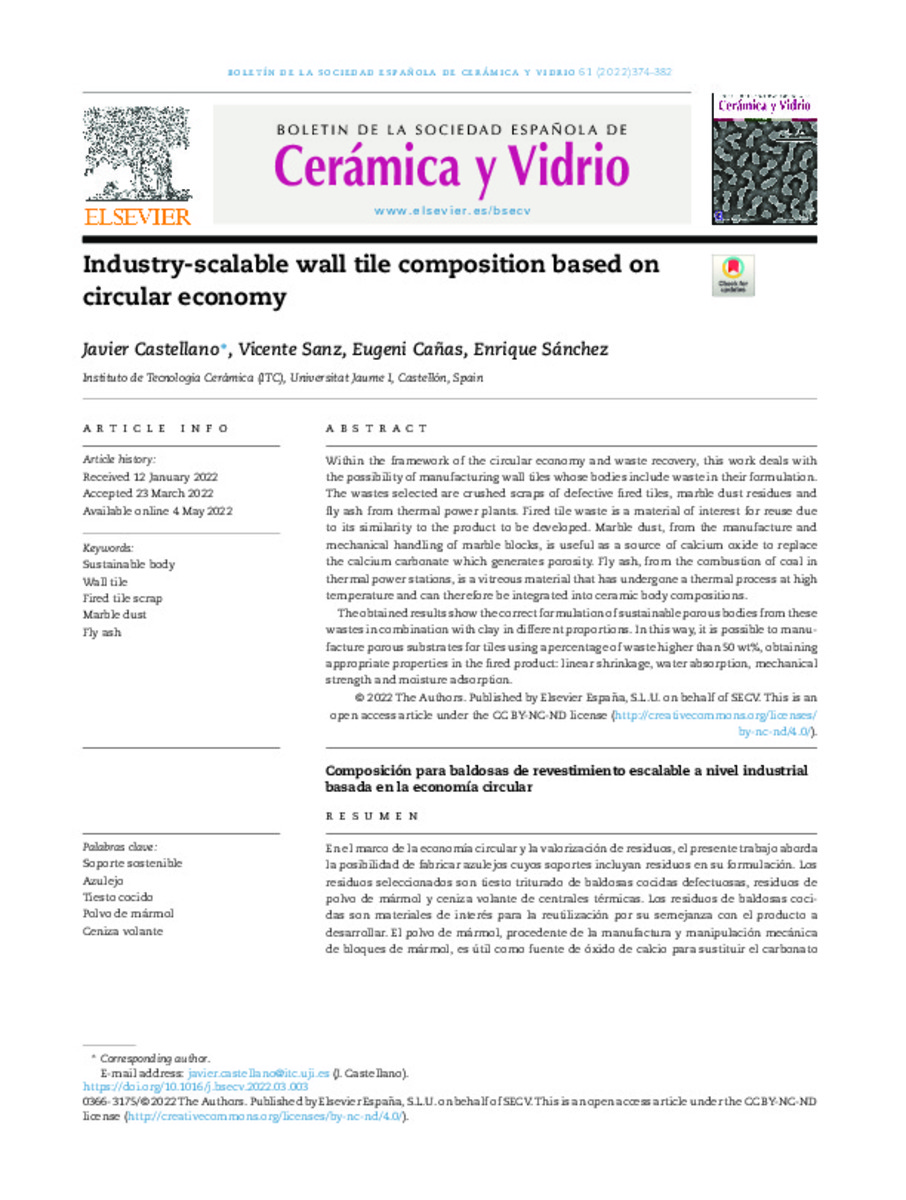Mostrar el registro sencillo del ítem
Industry-scalable wall tile composition based on circular economy
| dc.contributor.author | Castellano, Javier | |
| dc.contributor.author | Sanz-Solana, Vicente | |
| dc.contributor.author | Cañas Recacha, Eugeni | |
| dc.contributor.author | Sánchez-Vilches, Enrique | |
| dc.date.accessioned | 2022-09-22T07:47:51Z | |
| dc.date.available | 2022-09-22T07:47:51Z | |
| dc.date.issued | 2022-08 | |
| dc.identifier.citation | Castellano, J., Sanz, V., Cañas, E., & Sánchez, E. Industry-scalable wall tile composition based on circular economy. Boletín de la Sociedad Española de Cerámica y Vidrio, 61(4) (2022), pp. 374-382. | |
| dc.identifier.issn | 0366-3175 | |
| dc.identifier.uri | http://hdl.handle.net/10234/199701 | |
| dc.description.abstract | En el marco de la economía circular y la valorización de residuos, el presente trabajo aborda la posibilidad de fabricar azulejos cuyos soportes incluyan residuos en su formulación. Los residuos seleccionados son tiesto triturado de baldosas cocidas defectuosas, residuos de polvo de mármol y ceniza volante de centrales térmicas. Los residuos de baldosas cocidas son materiales de interés para la reutilización por su semejanza con el producto a desarrollar. El polvo de mármol, procedente de la manufactura y manipulación mecánica de bloques de mármol, es útil como fuente de óxido de calcio para sustituir el carbonato de calcio que genera porosidad. La ceniza volante, proveniente de la combustión del carbón en centrales térmicas, es un material vítreo que ha sufrido un proceso térmico a alta temperatura y que, por tanto, puede integrarse en composiciones de soportes cerámicos. Los resultados obtenidos ponen de manifiesto formulaciones optimizadas de soportes porosos sostenibles a partir de estos residuos en combinación con arcilla en diferentes proporciones. De este modo, es posible fabricar soportes porosos para baldosas utilizando un porcentaje de residuos superior al 50%, obteniendo unas propiedades en cocido adecuadas: contracción lineal, absorción de agua, resistencia mecánica y adsorción de humedad. | ca_CA |
| dc.description.abstract | Within the framework of the circular economy and waste recovery, this work deals with the possibility of manufacturing wall tiles whose bodies include waste in their formulation. The wastes selected are crushed scraps of defective fired tiles, marble dust residues and fly ash from thermal power plants. Fired tile waste is a material of interest for reuse due to its similarity to the product to be developed. Marble dust, from the manufacture and mechanical handling of marble blocks, is useful as a source of calcium oxide to replace the calcium carbonate which generates porosity. Fly ash, from the combustion of coal in thermal power stations, is a vitreous material that has undergone a thermal process at high temperature and can therefore be integrated into ceramic body compositions. The obtained results show the correct formulation of sustainable porous bodies from these wastes in combination with clay in different proportions. In this way, it is possible to manufacture porous substrates for tiles using a percentage of waste higher than 50 wt%, obtaining appropriate properties in the fired product: linear shrinkage, water absorption, mechanical strength and moisture adsorption. | ca_CA |
| dc.format.extent | 9 p. | ca_CA |
| dc.format.mimetype | application/pdf | ca_CA |
| dc.language.iso | eng | ca_CA |
| dc.publisher | Sociedad Española de Cerámica y Vidrio | ca_CA |
| dc.relation | New materials for a more sustainable and comfortable construction | ca_CA |
| dc.relation.isPartOf | Boletín de la sociedad española de cerámica y vidrio, 2022, vol. 61, no 4 | ca_CA |
| dc.rights.uri | http://creativecommons.org/licenses/by-nc-nd/4.0/ | ca_CA |
| dc.subject | soporte sostenible | ca_CA |
| dc.subject | azulejo | ca_CA |
| dc.subject | tiesto cocido | ca_CA |
| dc.subject | polvo de mármol | ca_CA |
| dc.subject | ceniza volante | ca_CA |
| dc.subject | sustainable body | ca_CA |
| dc.subject | wall tile | ca_CA |
| dc.subject | fired tile scrap | ca_CA |
| dc.subject | marble dust | ca_CA |
| dc.subject | fly ash | ca_CA |
| dc.title | Industry-scalable wall tile composition based on circular economy | ca_CA |
| dc.title.alternative | Composición para baldosas de revestimiento escalable a nivel industrial basada en la economía circular | ca_CA |
| dc.type | info:eu-repo/semantics/article | ca_CA |
| dc.identifier.doi | https://doi.org/10.1016/j.bsecv.2022.03.003 | |
| dc.rights.accessRights | info:eu-repo/semantics/openAccess | ca_CA |
| dc.relation.publisherVersion | https://www.sciencedirect.com/science/article/pii/S0366317522000255?via%3Dihub | ca_CA |
| dc.description.sponsorship | Acknowledgements to the Ministry of Science and Innovation of the Government of Spain and the European Regional Development Fund (ERDF) of the European Union for the funding received within the project “CONFORTMA RTC-2017-5904-5 New materials for a more sustainable and comfortable construction”. | |
| dc.type.version | info:eu-repo/semantics/publishedVersion | ca_CA |
| project.funder.name | Ministerio de Ciencia e Innovación | ca_CA |
| project.funder.name | European Regional Development Fund | ca_CA |
| oaire.awardNumber | CONFORTMA RTC-2017-5904-5 | ca_CA |
Ficheros en el ítem
Este ítem aparece en la(s) siguiente(s) colección(ones)
-
ITC_Articles [76]
-
QUI_Articles [296]








